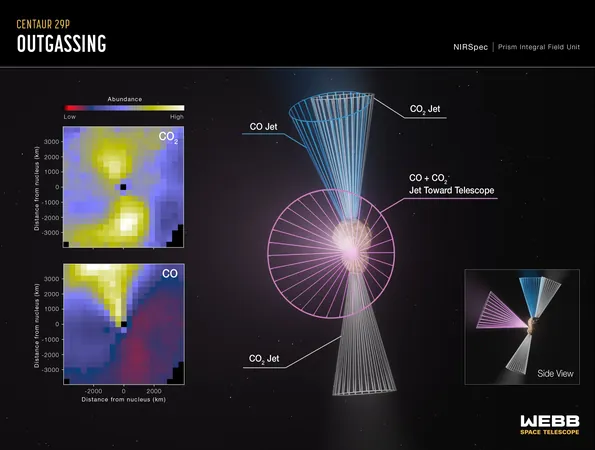
Groundbreaking Discoveries from Webb Telescope: Gas Jets Revealed in Centaur 29P!
2024-10-02
Introduction
In a stunning revelation that enhances our understanding of the solar system, NASA's James Webb Space Telescope has mapped unusual gas jets emanating from Centaur 29P/Schwassmann-Wachmann 1, a peculiar celestial object situated between Jupiter and Neptune. This phenomenon presents new opportunities to explore the rich history and evolution of our cosmic neighborhood.
What are Centaurs?
Centaurs are fascinating objects that were once trans-Neptunian—the icy bodies from beyond Neptune’s orbit—that have migrated inward due to gravitational influences. In a transitional phase, they exhibit characteristics of both cometary bodies and distant, icy objects, hinting at their possible future as short-period comets. Each of these centaurs acts as a time capsule, preserving clues about the conditions prevalent in the early solar system.
Recent Discoveries with the Webb Telescope
Recently, a team of researchers utilized Webb's advanced NIRSpec (Near-Infrared Spectrograph) to gather unprecedented data about 29P, which is notorious for its intense and periodic outbursts, occurring roughly every six to eight weeks. These eruptions make it one of the most active objects in our solar system, and the latest findings reveal jets of carbon monoxide (CO) and previously undetected carbon dioxide (CO2) gas, unveiling vital insights into the nature of its nucleus.
Significance of the Findings
As quoted by lead author Sara Faggi from NASA's Goddard Space Flight Center, 'Centaurs can be considered as some of the leftovers of our planetary system's formation,' emphasizing their role as remnants of ancient solar system processes. The Webb telescope, with its cutting-edge technology, has opened new doors to study these celestial objects in detail, captivating scientists at the first glance of the data.
Previous Limitations and New Observations
The faintness and distant orbits of centaurs have historically limited detailed studies. Past radio observations had already hinted at CO jets directed towards the sun and Earth. But Webb has taken it a step further—detecting these CO jets and identifying jets of CO2, marking the first definitive observation of carbon dioxide on Centaur 29P.
3D Modeling of Gas Jets
This information prompted researchers to develop a 3D model of the jets, offering insights into their origins and orientations. The variability in carbon monoxide and carbon dioxide distribution across the surface hints at a possible amalgamation of distinct elements—a clue that could reshape our understanding of primordial celestial body formation. As co-author Geronimo Villanueva noted, 'Maybe two pieces coalesced together, which challenges our ideas of how primordial objects are created.'
Unanswered Questions
However, many questions remain unanswered. The exact triggers behind 29P’s sporadic brightness and the specifics of its outgassing processes require deeper investigation. Unlike comets, which largely rely on sublimating water ice to produce jets, the icy conditions of centaurs prevent water from transitioning into vapor. This prompts scientists to consider alternative mechanisms for their distinctive outgassing activities.
Future Investigations
Renowned astronomer Adam McKay expressed the desire to revisit Centaur 29P for extended observations to unravel the mysteries surrounding its jets and brightness variations. 'Observing over a longer duration could unlock secrets about the dynamics driving these fascinating outbursts,' he noted.
Conclusion
The research team is thrilled at the prospect of applying their methods to study other centaurs, paving the way for a deeper understanding of our solar system's formation. As we continue to explore these enigmatic celestial bodies, who knows what other secrets they may reveal about the history of our cosmic past? Stay tuned for more exciting discoveries as we push the boundaries of space exploration!

 Brasil (PT)
Brasil (PT)
 Canada (EN)
Canada (EN)
 Chile (ES)
Chile (ES)
 España (ES)
España (ES)
 France (FR)
France (FR)
 Hong Kong (EN)
Hong Kong (EN)
 Italia (IT)
Italia (IT)
 日本 (JA)
日本 (JA)
 Magyarország (HU)
Magyarország (HU)
 Norge (NO)
Norge (NO)
 Polska (PL)
Polska (PL)
 Schweiz (DE)
Schweiz (DE)
 Singapore (EN)
Singapore (EN)
 Sverige (SV)
Sverige (SV)
 Suomi (FI)
Suomi (FI)
 Türkiye (TR)
Türkiye (TR)